The Village Idiot

|
May 2000 Issue
Villaging in the HO Scale
|
|
The biggest difference between villaging in HO scale
and the scale of most ceramic light ups besides
the size is that HO Scale buildings are usually model kits.
So why would you bother villaging in a smaller
scale like HO or even N? Besides the fact that you can
have a larger village in the same amount of space
as a ceramic village. You can also customize the buildings
to a greater extent. And then there is the price
a building like the refreshment stand featured in
this article is only about five dollars. But if that's
not enough here is what I think is the best reason
( and this is the reason I do it) it's an
awesome way to show off your 1-6x diecast car collection.
Including the cars as part of a village scene is much
more interesting then lining them up on a shelf.
|
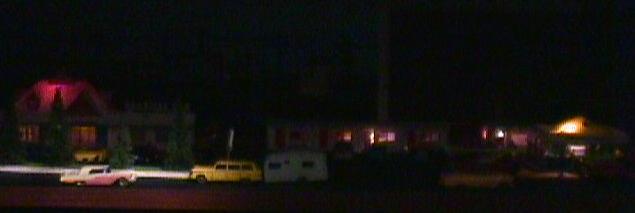 |
|
Take a look at the scene above. It looks like a skyline
in the distance, doesn't it? This is actually a shot of one part of my
HO Scale Village. There are three buildings in this scene: The Refreshment
Stand, the Motel, and the Restaurant. |
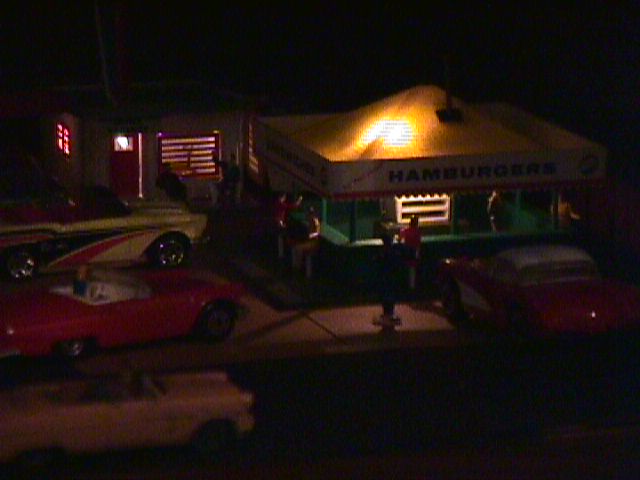
Let's take a closer look at the refreshment stand (right).
The refreshment stand is actually a kit from Atlas Model Railroad. I really
like this kit, so I haven't made many changes to it. The two biggest changes
are that I painted the tops of the bar stools red, and I installed a light
under the canopy. Let's turn on the lights so we can get a better look
at this scene (below.) |
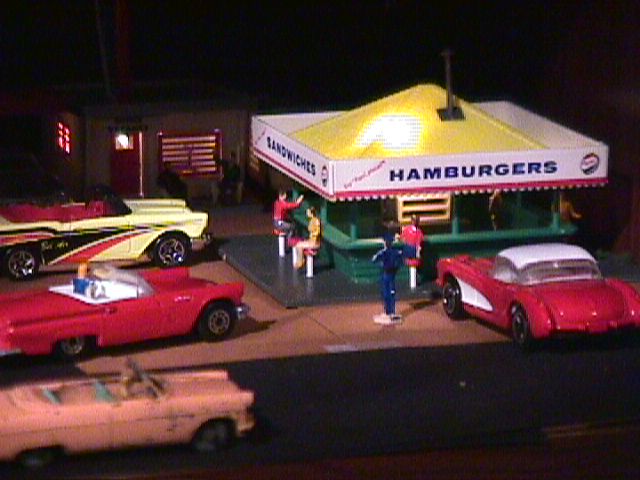
One of the first things you notice is what happens when
you place too much light on the scene. In the bright light you can see
the details of everything you are looking at. It's immediately apparent
that this is a model scene and those are 1-6x die cast cars. Remember that
the idea in building a diorama scene is to fool the eye. The way to fool
the eye is by not providing it with
an excess of information, and that information for the
human eye comes in the form of light.
Remember that when you are planning your ambient lighting
for a scene. Don't over light it; it ruins the effect.
As you can see, this scene is made up of an HO scale building,
some people and some 1-6x die cast cars. (See March Issue for a
discussion on these model cars). In this case, all the cars are "Matchbox"
and most of them are later models (80's and 90's, even though the model
year cars are in the 50's) They are: The '57 Chevy Bel-Air (in the background),
the '57 Ford Thunderbird, and the '57 Corvette. The '56 Ford Zodiac convertible
(on the road in the foreground) is the only car in the scene actually built
in the 50's. The road is made from black art paper (black art paper is
better than poster board or some other black papers because it has a grain
similar to asphalt and absorbs light with little reflection.) The "dirt
parking lot" around the refreshment stand is brown art paper.
|
 The people are Atlas Model Railroad HO scale people. These are purchased
as a kit of unpainted figures. Painting the people was actually the most
time-consuming task in this scene. One challenge was that the sitting people
had to be permanently glued to the barstools to get them to stay put. The
good news is that these people are very inexpensive, so you can easily
have a large number of people in your village without spending a lot of
money. That's another advantage over ceramic villages
The people are Atlas Model Railroad HO scale people. These are purchased
as a kit of unpainted figures. Painting the people was actually the most
time-consuming task in this scene. One challenge was that the sitting people
had to be permanently glued to the barstools to get them to stay put. The
good news is that these people are very inexpensive, so you can easily
have a large number of people in your village without spending a lot of
money. That's another advantage over ceramic villages
|
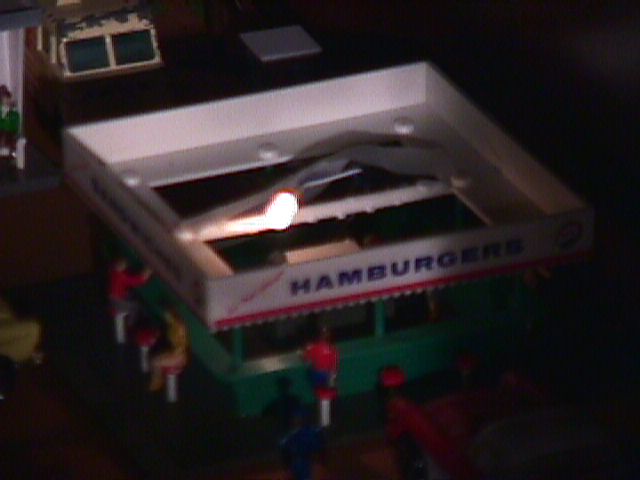 The third change I made to the refreshment stand was not to glue the canopy
in place. I did this so I could reach the inside of the structure to easily
install a lamp and to allow for any modifications I might wish to make
in the future. Clearly, this is another advantage of HO scale building
kits. In the pic on the left, you see the stand with the canopy removed.
This allows you to see how I installed the lamp. It was easy enough to
do; I simply soldered a permanent 6 volt miniature lamp to a length of
solid copper two conductor wire (speaker wire in this case). Then I wrapped
the solid wire around the frame strut in the top of the model and secured
it with a piece of tape. The light provides the dual effect of lighting
the inside of the canopy and shining down into the structure at the same
time.
The third change I made to the refreshment stand was not to glue the canopy
in place. I did this so I could reach the inside of the structure to easily
install a lamp and to allow for any modifications I might wish to make
in the future. Clearly, this is another advantage of HO scale building
kits. In the pic on the left, you see the stand with the canopy removed.
This allows you to see how I installed the lamp. It was easy enough to
do; I simply soldered a permanent 6 volt miniature lamp to a length of
solid copper two conductor wire (speaker wire in this case). Then I wrapped
the solid wire around the frame strut in the top of the model and secured
it with a piece of tape. The light provides the dual effect of lighting
the inside of the canopy and shining down into the structure at the same
time.
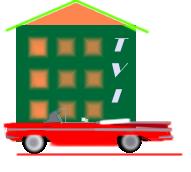
If you have any questions about this article drop me a line at [email protected] or
just press here. Webmaster
|



 © 2000
© 2000
Article and Photos by Andrew L Barnhill, Edited by Maureen
Sheridan, © 2000 Tornado Science. All rights reserved.
Atlas model railroad is a trademark of Atlas Tool Company Hillside, NJ.
Matchbox is a registered Trademark of Mattel Inc.
Chevy, Bel-Air, and Corvette are registered trademarks of General Motors
Corporation. Thunderbird and Zodiac are registered trademarks of
Ford Motor Corporation.




 The people are Atlas Model Railroad HO scale people. These are purchased
as a kit of unpainted figures. Painting the people was actually the most
time-consuming task in this scene. One challenge was that the sitting people
had to be permanently glued to the barstools to get them to stay put. The
good news is that these people are very inexpensive, so you can easily
have a large number of people in your village without spending a lot of
money. That's another advantage over ceramic villages
The people are Atlas Model Railroad HO scale people. These are purchased
as a kit of unpainted figures. Painting the people was actually the most
time-consuming task in this scene. One challenge was that the sitting people
had to be permanently glued to the barstools to get them to stay put. The
good news is that these people are very inexpensive, so you can easily
have a large number of people in your village without spending a lot of
money. That's another advantage over ceramic villages
 The third change I made to the refreshment stand was not to glue the canopy
in place. I did this so I could reach the inside of the structure to easily
install a lamp and to allow for any modifications I might wish to make
in the future. Clearly, this is another advantage of HO scale building
kits. In the pic on the left, you see the stand with the canopy removed.
This allows you to see how I installed the lamp. It was easy enough to
do; I simply soldered a permanent 6 volt miniature lamp to a length of
solid copper two conductor wire (speaker wire in this case). Then I wrapped
the solid wire around the frame strut in the top of the model and secured
it with a piece of tape. The light provides the dual effect of lighting
the inside of the canopy and shining down into the structure at the same
time.
The third change I made to the refreshment stand was not to glue the canopy
in place. I did this so I could reach the inside of the structure to easily
install a lamp and to allow for any modifications I might wish to make
in the future. Clearly, this is another advantage of HO scale building
kits. In the pic on the left, you see the stand with the canopy removed.
This allows you to see how I installed the lamp. It was easy enough to
do; I simply soldered a permanent 6 volt miniature lamp to a length of
solid copper two conductor wire (speaker wire in this case). Then I wrapped
the solid wire around the frame strut in the top of the model and secured
it with a piece of tape. The light provides the dual effect of lighting
the inside of the canopy and shining down into the structure at the same
time.



 © 2000
© 2000